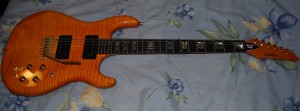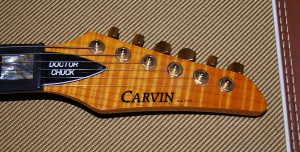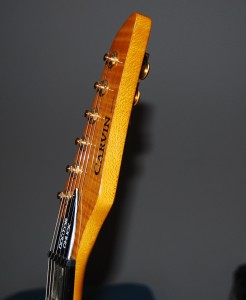Archive for November 17th, 2013
Today’s rant: Carvin Guitars: Why you will soon want one!!:
And so it dawned on me that being my welcome photo is one of me playing my Carvin DC400, I figured that I would make Carvin guitars the topic of today’s rant. First off I’d like to say that Carvin guitars are arguably the most highly underrated most excellent instruments on the market and on the planet. I have played more than my fair share of Gibsons, Fenders, PRS’s and what have you and Carvin is right up there with them build quality wise, playability wise, and sound wise. In fact it is my most often chosen “go to” guitar whenever I play out. This guitar is pretty much bullet proof and reliably delivers the goods time after time. A proven dependable work horse of a guitar for sure. It is also gorgeous in my humble opinion.
I cannot tell you how many times I will play the DC 400 out that people either in the audience or fellow musicians will remark how great the tone and clarity of this guitar is. Then usually the next question is; “What brand is it?”. I respond; “Carvin”. The usual follow up to that is; “Never heard of it”, which incredibly does not surprise me at all. Then I get; “A new brand?” I tell them; “Only been around since 1946….”
“Say what? Ya kidding me!”
“Nope, serious as a heart attack!”
After that they remark how much they are impressed and want to check it out etc. And so it goes.
Lowell C. Kiesel established the company in 1946 as the L.C. Kiesel Company. At around 1950 he changed the name to Carvin after his two eldest sons Carson and Gavin and the rest as they say, is history..
And so despite being on the planet for more than a few decades, the reason for its somewhat surprising obscurity is that you won’t see a Carvin guitar hanging off a wall in your local Guitar Center or Sam Ash outside of the occasional find on the used rack. Carvin does not do retail. They are factory direct except for a handful of stores in California.and in these stores you will likewise not see any Gibson or Fender guitars because these are Carvin stores. Their rationale is that by bypassing the middle man, they can sell direct to the customer for a far better price claiming that their guitar would sell for much much more if they were in local music stores. Another thing is that while seeming relatively obscure, there are some accomplished professionals who play these Carvins; Craig Chaquico, Allan Holdsworth, and Joe Walsh just to name a few. Amazingly despite some high profiles using a Carvin as their instrument of choice, these guitars still remain one of America’s best kept secrets it might seem.
There are many things I love about my Carvin besides its quality and beauty. It is a very versatile guitar sporting active and passive circuitry with treble and bass boost AND cut, as well as coil taps for each pick up and an out of phase switch for a nice hollow mid-range boost. And so you can get everything from roaring humbucker tones, to twangy single coil sounds; flip the phase switch and get a Fenderish quack which although it does not get the genuine Knopfleresque in between sounds 2 and 4, does an admirable job of covering many bases without having giving the player a need to switch guitars. The pick ups are really unique as well. They have eleven pole pieces instead of six which Carvin claims eliminates dead spots in between the strings and results in more even volume, especially on string bends where the string usually veers off the pole piece. Also there are three height adjustment screws on the pickup frame; two on the bass side and one on the treble side. This not only allows for height adjustment but also angulation so you can parallel the string path. Pretty neat. How many times do you adjust the height on your Les Paul humbucker and find that the pole piece end of the pickup is angled less than ideally into the body, and you can’t do a darn thing about that ?! Kudos to Carvin for their attention to detail and a simple but effective innovation.
The controls are really cool. Like I said this is an active/passive wiring harness that is activated by a push pull master volume pot where as many guitars with active electronics are ONLY just that and have the battery for power, usually a 9 volt, mounted underneath the pick guard. What happens when the battery dies in the middle of your set? Unless you have a spare guitar, you are fubar-ed my friend for you have to deal with a most cumbersome battery replacement procedure to get the guitar up and running again. This means that in the dark lighting of a club, you are faced with unscrewing all those little pick guard screws to remove the pickguard to gain access to the battery while also making sure you don’t lose any of those pesky little screws rolling around whatever and then ultimately disappearing into the cosmos. Doh!!! If this is a Stratocaster like guitar or say one of those Fernandez guitars with the sustainer system, this probably means you have to also Waaaaaayyy loosen all the strings to be able to gain clearance for sliding that pickguard out. You get the picture.., a technical nightmare under the worst possible conditions. You might be more inclined to say the heck with this and do a Jimi Hendrix like “set da bastid on fire guitar smashing!!!” out of total frustration.
Hmmmm,……Wonder how many Stratocasters Jimi destroyed in his career. Who knows. The only thing I remember was that before each tour he would go to New York City and visit Manny’s and Jimmy’s to pick out about twenty Stratocasters. At that time they were going for about $200.00 or so a piece which by the standard of those times was still not cheap. Anyway because left handed Strats were about as rare as hen’s teeth, his tech would then take these twenty or so Strats, change the nuts and bridge saddles to left handed and then restring them up for Jimmy. Wonder what those Strats would be worth now if instead, Jimi simply retired them after a tour without smashing and burning them. Then again, if there are any existing Strat fragments from his smashed guitars, I wonder what those would claim now….. It was once said that they took the sheets from the beds in the hotels when The Beatles and Elvis would be on tour and cut them up into it inch square pieces and sell them off to the hysterically screaming teenage girls. Wonder what those would be worth now… It was also said that in the heyday of Chuck Berry when there was no such thing as light guage strings he would take a standard set, discard the low E string and then use the A string as the low E and string his 335 all the way up to the B when he would run out of strings. Then he would use a banjo string for the high E string so he could then do his famous chord like string bends with his impromptu “Chuck Berry Lights”……….And so what does this have to do with all things Lowell C. Kiessel? Nothing,… Absolutely NUTTIN!!!!! So let’s get back on topic pronto, yeah?!!!! Sheesh!!!!!!!
Anyway, so here you are freaking out because your battery went dead as your guitar goes totally silent and you can’t decide whether you want to smash your guitar or your head, or BOTH, into nearest wall, or set your guitar on fire before smashing it, or set yourself and your guitar on fire simultaneously and go out in a blaze of glory!!…. Enter the Carvin active/passive system. Ahhhhhhhhhhhhhhh………. . Take a sip from that Miller 64 beer can seated on your amp head. Relief is just a swallow away! You are set in active mode and in the middle of the set suddenly the battery goes dead on your Carvin DC400. So far the scenario is the same. This time though, without missing a beat, you pull out your push pull master volume and INSTANTLY engage the passive circuit; quickly adjust your volume no one being the wiser, and seamlessly continue to play. You finish the song and then you finish the set without a glitch. Then over the break and even in the dim light, you simply and briskly spring open the door to the battery compartment on the back of the guitar, remove the dead battery and replace it with a fresh one, all in just a few seconds. MUCH better!!!Now this is living baby!!! This is HUGE!! Much, much better than a most flame filled demise…Yeah!!!!
Another very cool feature is the Wilkenson tremolo system (also available hard tail ) that allows you to pull notes up as well as down. Dive bombing is a breeze for those of you EVH wannabes and then the return to pitch is predictably spot on not only due to this freely anchored and smoothly floating trem but also due to the Graph Tech graphite bridge, Sperzel locking tuners, and the total absence of string grabbing Fender style string trees to keep the strings tensioned against the nut. Instead Carvin pitches the headstock back fourteen degrees to accomplish the same thing without those dastardly string grabbing string trees.
And so boys and girls what is the weakest part of a tremolo system that is MOST responsible for throwing a guitar out of tune?
Answer: The nut. Yes, the nut! Binding at the nut during those trem excursions grabs the string and holds it at a new position either sharp or flat of origin and the result is it sounds like you don’t know how the heck to tune a guitar! I don’t care how good your trem system is or if you have locking tuners, or how well you play. If your nut binds your strings, you WILL go out of tune the first time you lean on that tremolo bar. And so there are remedies for this. The graph tech bridge is one. Being made of graphite, it actually slightly microscopically delaminates while the string is moving to and fro across the nut during a trem excursion and these little teeny weeny graphite molecules slide around and act as a lubricant to prevent the string from binding. Pretty cool, ayy?
For bridges that are not made of such material, the best thing to do is make sure that your nut is properly cut. This might seem like a no brainer, but I’ll tell you, I have had a couple of Gibson custom shop models that are losers in this regard, most notably my beautiful white Gibson Les Paul SG Custom with the lyre tremolo. Lean into that baby and it is “Out of Tune City” despite the stiff Custom Shop price tag. I had to recut the G, B, and high E slots so that they did not bind and luckily there is this great stuff out called Big Bends Nut Sauce that you can apply to the nut slots. This grayish viscous snotty looking stuff is liquid graphite and a miracle in a bottle which works wonders even of your guitar is not tremolo equipped because even string bends can cause the string to bind in the nut to a new position affecting its pitch. And so if you ever find yourself tuning up your guitar and you hear the strings go “cheenk”, “cheenk”, and then there is a more than expected pitch change, your nut is binding fella! Now go out and get yourself some Big Bends Nut Sauce on the double, ya hear?!!
Now these Carvin guitars are made to order if you like. Pick a model, choose your features and design YOUR guitar. This is exactly what I did with mine.I wanted a Wilkenson trem, active/passive electronics, graph tech nut, and Sperzel locking tuners. I also wanted strap locks but they only offered Dunlop and I wanted Shallers, so I put them on myself. The design on the Shallers is less bulky and I also have them on other guitars which would make the straps interchangeable if I so desired. I went with the stock pickups but they had others available. Other CARVIN pickups that is. Yes, They even wind their own pickups! Cool!
I also wanted flamed vintage yellow. Nebulous looking quilt tops sort of confuse my brain and I’m confused enough most of the time. To me there is nothing like a tight uniform tiger stripe chevron nicely book matched piece of maple angling down from the center. Nice. The guitar is also neck through deigned which I also like. Nice smooth slim heel with great access to even the highest frets. Smooth as slate Ebony fingerboard and abalone block inlays. Sweet! The fingerboard is wide and the neck is slim. To some, it may take some adjusting to. I loved it from the get go, but then again I also loved broccoli rabe the first time as well. The body is made from solid alder which is light weight but tonally quite resonant. The flame maple top gives the guitar much brightness although if you use just the neck pickup in humbucker mode with the tone pot rolled back you can get great Clapton “Woman Tone”. Even just tapping on the guitar unplugged the wood has a nice ring to it! Sort of like when Moe taps on Curly’s head or something like that.
And so it goes, that considering I picked and chose most of the features and sort of designed this guitar for only me, I decided to spring a few dollars for the custom engraved Truss rod cover. I think it was like seven dollars for a cheap piece of plastic but What the heck?!! And so I called it the Carvin DC400 Doctor Chuck model! Hahaha!!! My buddy Dr. Renrick C. Benn who is a local oral surgeon and dental school colleague would probably tell me; “Billera, you beat your own drum and dance to your own music!” in his most inimitable fashion……Well, maybe,… sometimes. Why the heck not? It’s just some harmless fun, and it is my damn guitar right? I can do what I want with it, buddy. Okay?! I’ll kick and smash and set it on fire okay?……………….Never!
Sometimes, I think that part of Carvins name recognition problem is due to the versatility of designing your own instrument. It also might cloud up the distinction of the models just a bit. Think about this. For instance my guitar is a DC400, but being that you can really build one that is quite different depending on the feature you want, it is in a sense then, a different guitar, yet it has the same name designation. When for example you buy a Gibson Les Paul Standard you cannot specify that you want block mother of pearl inlays and an ebony board. If you want those features you will have to choose a Les Paul Custom, right? And so not having the ability to swap and choose features with a Gibson Les Paul actually acts as a mark of distinction between the two models and clarifies their identity. And so where am I going with this? Simply here. It appears that the versatility of building your Carvin to your specifications may act like a double edged sword in terms of actually defining a certain instrument and this may present to the potential buyer as not having a particular model that is just “THIS” and nothing else. Could be why when people ask what my guitar is this is they really don’t have a clue, because the designation DC400 may stand for a group of guitars. Sure there are a lot of Les Pauls, but they all have their own specifications and hence their own names and identities. On the other hand Carvin has been around since 1946, so I just might be simply blowing smoke out my shorts!!! Like what the heck do EYE know?!!! Ya can’t argue with success I suppose and Carvin sure had proven that it has staying power which is a nice thing in this day and age for an American guitar company, indeed!!!
To me this guitar does it all, and if I was to be stranded on an island this would be the guitar I would want. Of course that island would have to have electricity for an amp and for a refrigerator to keep those Miller 64’s cold for me and the ladies. Ladies? What ladies? Did I say ladies?? Well, if ya gonna be stranded and HAVE to choose only one guitar, you should at least be able to dream about the other of barest essential “staples” you would need for survival, yeah?
Alright time to get out of here!!
Until next time, thanks for your indulgence in my rant!
For further reading:
http://www.carvinguitars.com/catalog/guitars/dc400







